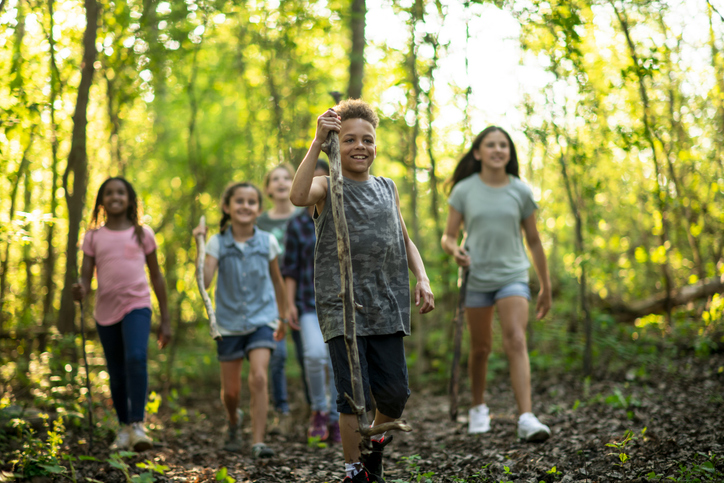Connecting Children with Nature to Improve Mental Well-Being
Children and teens face a variety of stressors and concern about youth mental health has increased in recent years. These issues were highlighted in the U.S. Surgeon General’s advisories on Protecting Youth Mental Health, Social Media and Youth Mental Health and Loneliness and Isolation. One approach gaining more attention is tapping into the health benefits of spending time outdoors in nature.
Research is increasingly pointing to the benefits of providing children with regular access to green space. A review published in the Journal of Pediatric Nursing concluded that access to green space was associated with improved mental well-being and overall health. Additionally, the study found that access to green space promotes memory, supportive social groups, and self-discipline, moderates stress, and improves behaviors and symptoms of ADHD.

Access to green spaces may be especially beneficial for socioeconomically disadvantaged youth. For example, a 2021 study published in Wellbeing, Space, and Society, looked at the social, emotional, and behavioral well-being of more than 700 children aged 10 to 11 and the amount of green space they had available. They used satellite images to determine the green space available in the children’s neighborhoods. The study found that a 10% increase in neighborhood green space was associated with a decrease in emotional problems and improvement in positive social behaviors. These benefits were especially strong among youth from lower-income families.
Connecting with nature in a more structured way through forest therapy has also shown benefits. A recent study looked at the psychological and physiological health benefits of structured forest therapy programs for children and adolescents with mental health disorders. The study involved children and youth (aged 9–14 years) participating in two one-hour guided forest therapy experiences using slow mindful and sensory communication with nature. They found that positive mood significantly improved, negative mood (tension, depression, anger) was significantly reduced, and mindfulness and physiological health were significantly boosted with the intervention.
Programs for Families
Beyond the research, several organizations are putting these benefits into practice. At the Center for Nature and Health at the University of California, San Francisco pediatrician Nooshin Razani, M.D., M.P.H., established a program to reconnect children with the natural world. The program, Stay Healthy in Nature Every Day (SHINE), works in partnership with the East Bay Regional Parks District to provide local low-income families exposure to the outdoors and environmental education. It also trains doctors to “prescribe” nature. The Children & Nature Network, a national nonprofit working to increase children’s equitable access to natural spaces, has partnered with the National League of Cities on the Cities Connecting Children to Nature initiative. The effort has worked to enhance the youth-nature connection in more than 50 cities.
“We shouldn’t be saying nature is just a luxury or that it’s O.K. that only the most advantaged kids who live near wonderful parks get to go there,” Cathy Jordan, Ph.D., told Psychiatric News. Jordan is the director for leadership and education at the Institute on the Environment at the University of Minnesota and director of research for the Children & Nature Network. “We actually have enough information to say it’s potentially powerful enough that we would be remiss not to provide equitable access to all kids, especially those who have the most to gain.”
More information
- Children and Nature Network
- Library of peer-reviewed research
- Resources – toolkits, reports, infographics, etc.
- UCSF Center for Nature and Health
Note: This blog is adapted from "Movement Aims to Reconnect Children With Nature," Katie O’Connor, Psychiatric News, Dec. 23, 2023
References
- Kil, N., Kim, J. G., Thornton, E., Jeranek, A. (2023). Psychological and Physiological Health Benefits of a Structured Forest Therapy Program for Children and Adolescents with Mental Health Disorders. International Journal of Mental Health Promotion, 25(10), 1117–1125.
- McCormick R. Does Access to Green Space Impact the Mental Well-being of Children: A Systematic Review. J Pediatr Nurs. 2017 Nov-Dec;37:3-7. doi: 10.1016/j.pedn.2017.08.027.
- Núria de la Osa, N., et al. 2024. Long-term exposure to greenspace and anxiety from preschool and primary school children. Journal of Environmental Psychology, Volume 93, February 2024. https://doi.org/10.1016/j.jenvp.2023.102207
- O’Connor, K. 2023. Movement Aims to Reconnect Children with Nature. Psychiatric News, Dec. 22, 2023. https://psychnews.psychiatryonline.org/doi/10.1176/appi.pn.2024.01.1.11
- Vanaken, G. J., & Danckaerts, M. (2018). Impact of Green Space Exposure on Children's and Adolescents' Mental Health: A Systematic Review. International journal of environmental research and public health, 15(12), 2668. https://doi.org/10.3390/ijerph15122668
